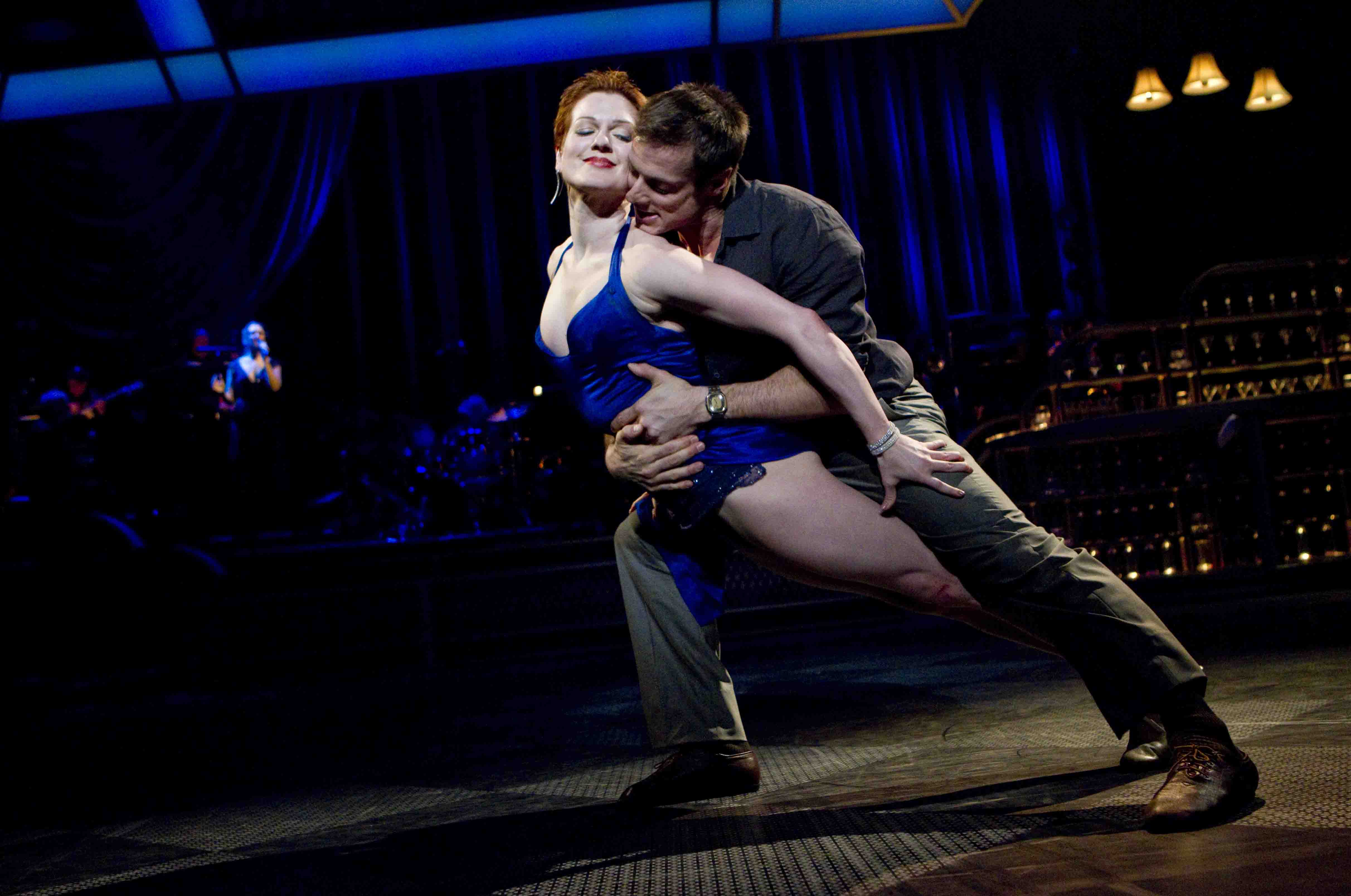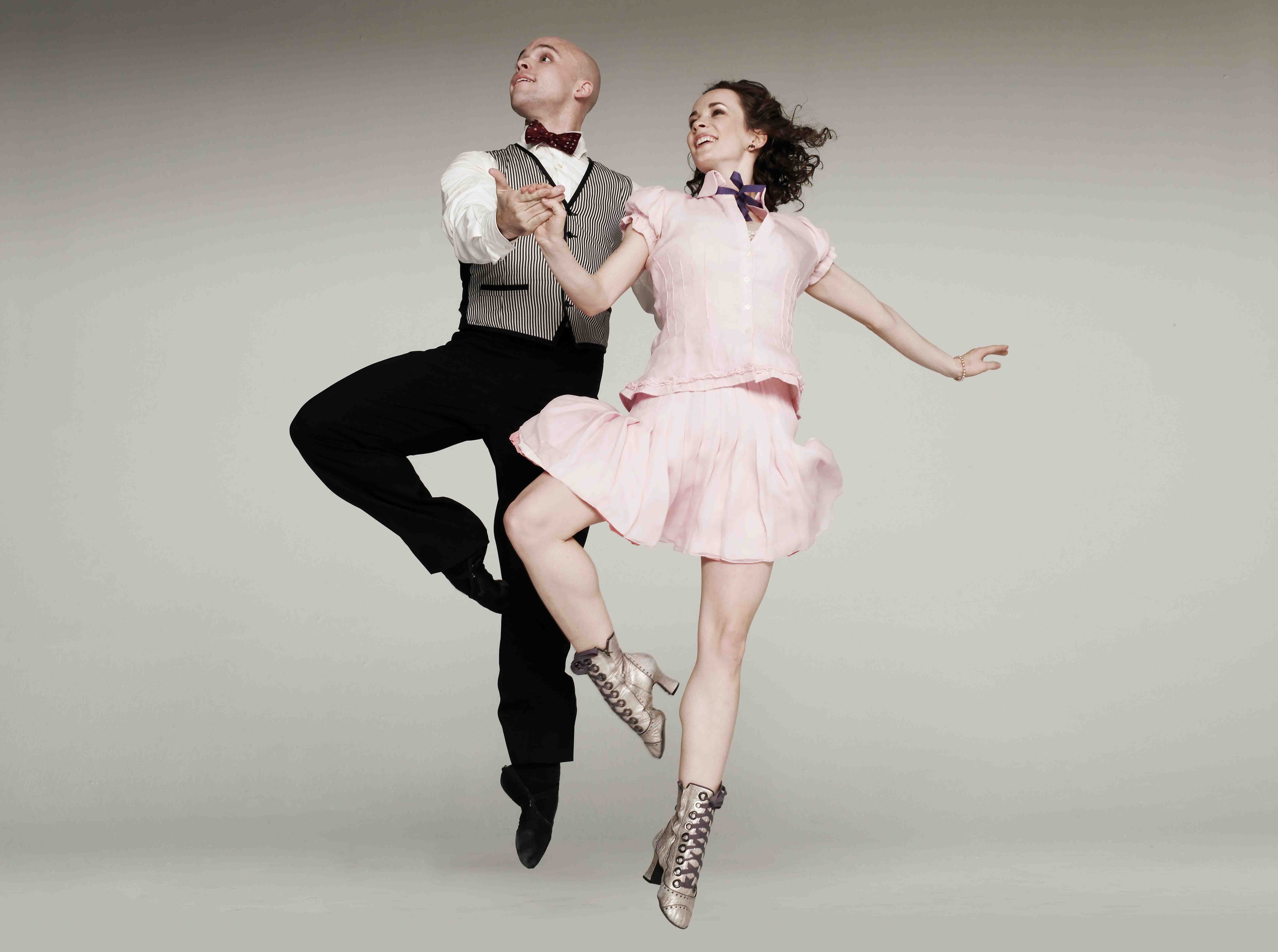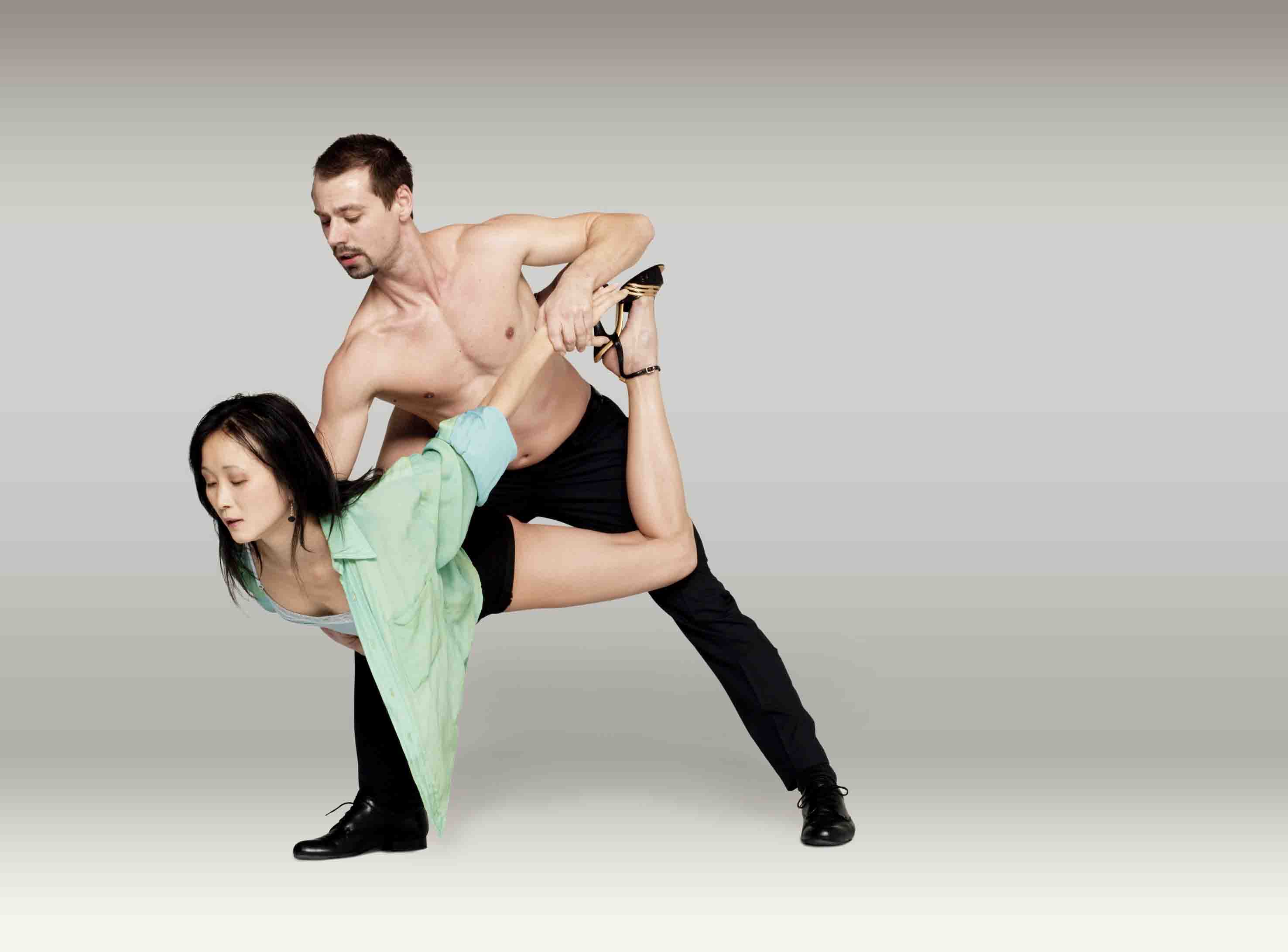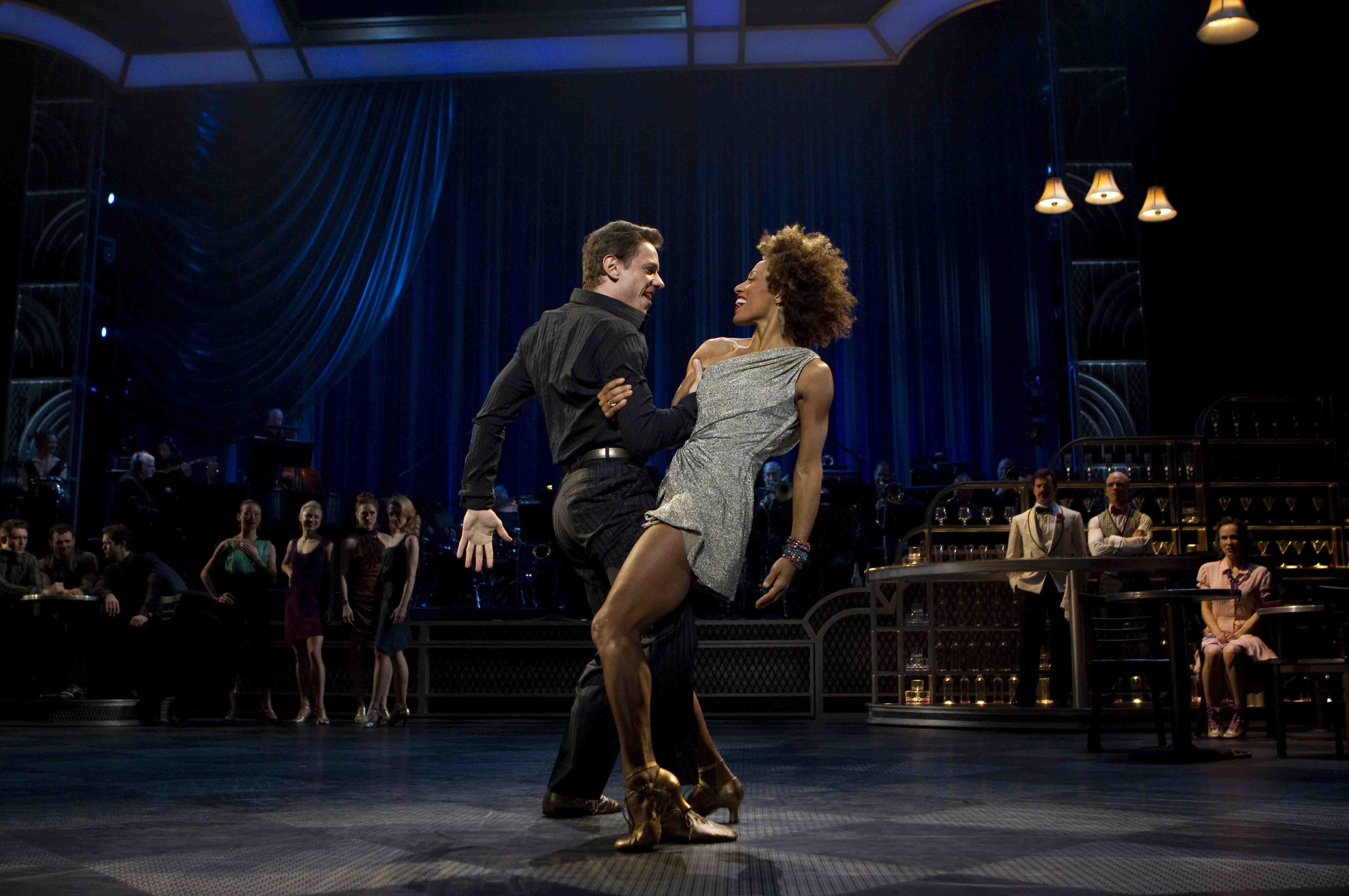Come Fly Away / Marquis Theatre, NYC / New York premiere March 25, 2010
Given Twyla Tharp’s incisive intelligence and no-holds-barred manner, you’d never expect her to fall for the sentimental, beguiling songs of Frank Sinatra, but she has, over and over again. Come Fly Away, which opened at the Marquis Theatre March 25 after three weeks of previews, is the latest result. Considering Tharp’s investment in the show–the talent, the time, the cultivation of backers (the cost of such entertainments is astronomical), the grueling effort to get it to Broadway–I wanted it to be wonderful. It isn’t.
For one thing, it’s hard to know what the show’s “about.” Its website, which seems to be pitching the production as a kind of Valentine’s Day stimulus, reveals only that “Fifteen of the world’s best dancers tell the story of four couples falling in and out of love at a swinging nightclub on a star-lit evening.” Journalists covering the musical’s premiere in Atlanta last fall (when it was called Come Fly With Me) or writing previews for its New York opening did a lot of explaining about each figure in the eightsome and the vagaries of their love lives as Tharp describes these things in interviews. From this evidence, you’d assume the show has solid characters and a clear plot. But if you just walk into the Marquis and simply watch what’s going on onstage, you’ll be hard put to figure out what’s going on narrative-wise, let alone who’s who.

Holley Farmer and John Selya in Twyla Tharp’s Come Fly Away
Photo: Joan Marcus
Of course, you know where you are, from James Youmans’s gaudy set, which suggests an Art Deco drinks-and-dancing nightspot–on steroids. Spacious enough for dancing on an intimate scale, it also provides an upstage platform for a 19-piece band (conducted by Russ Kassoff), a well-stocked bar to the right, a sprinkling of small tables and chairs, and a backdrop that assures us the night is full of stars. Katherine Roth’s costumes are simple and timeless, all swirl and sheen. This elegance is punctuated, when the going gets hot, with vulgarity that is, alas, overdone and, worse still, unimaginative.
About that band: While it’s live, it accompanies the actual Sinatra’s caressing voice, scooped out of the crooner’s recordings. (The digitized Sinatra is relieved from time to time by the live and lovely vocalist Hilary Gardner.) But maybe we shouldn’t be so picky concerning this curious arrangement. After all, Sinatra’s family and estate have given their blessing to the entire project.
The oddity of Come Fly‘s means of capturing Sinatra turns out to be the least of the show’s difficulties. The brazen gaudiness of the whole affair is another, but that’s show biz. The central flaw is that the audience is left to intuit a story or stories from hints in a continuum of some of the busiest dancing it has ever seen. If the show does have a plot (or even a point beyond the observation that love’s tough), it’s not all that clear.
We meet each of the four main couples in their relationships of the moment, but they soon split–through temperamental differences, quarrels, misunderstandings, or the cruel desire to try out an alternative lover. As if someone had yelled, “Change partners and dance!” the eight “characters,” most of whom are given no more depth than paper dolls, are shuffled like a deck of cards. About half of them seem to get together again as the show moves toward its finale, but by that time–exhausted by the volatile coupling, the incursions of a feisty ensemble, and the merciless visual cacophony–I, for one, had lost track.

Charlie Neshyba-Hodges and Laura Mead
Photo: Ruven Afanador
Back in the Sixties, when Tharp began choreographing, she worked in the world of concert dance–eschewing even theaters at the start; one terrific piece was performed in Central Park, in a field of grass. Abstract or semi-abstract choreography were the prevailing modes. Tharp didn’t need to worry about narrative chops. And hers have since proved to be conspicuously weaker than her dazzling invention in the realm of movement.
Tharp being Tharp, though, once she fixed on the Great White Way as her goal, was bent on effecting radical changes in the Broadway musical’s conventions, dispensing with spoken narrative and allowing dance and song to be the sole conveyors of events and emotions. Her 2002 Movin’ Out, set to Billy Joel’s music–a tremendous hit, running for three years and garnering a Tony award–was created along these lines. Next up, in 2006, was The Times They Are A-Changin’, to Bob Dylan songs. It was a colossal flop.
Now we have Come Fly Away, the fourth of Tharp’s rendezvous with Sinatra. Its predecessors?

Rika Okamoto and Matthew Stockwell Dibble
Photo: Ruven Afanador
Once More Frank (1976), a duet created for an American Ballet Theatre gala, in which Tharp juxtaposed her own maverick style–a delicious mix of ballet, jazz, modern, boxing, pedestrian moves, et al.–with Mikhail Baryshnikov’s pure classicism.
Nine Sinatra Songs (1982), created for the company Tharp maintained at the time, remains her best effort in tandem with Ol’ Blue Eyes. It’s simply a string of duets for different pairs rendered in suite form. The nature of each of the relationships portrayed–sublime, troubled, violent, romantic, ebullient, sweetly bumbling–is crystal clear and entirely satisfying, not least because it leaves the impression of real people, real situations, and real feelings. Generalized and idealized as it is, the viewer comes away from it thinking, Yes, that’s what love is like.
Some of the material in this piece resurfaces in Come Fly Away, rethought and reworked. True, it fits our era that the apache dance, which originally (and traditionally) gave us woman-as-victim, now shows us a woman who gives as good as she gets. Overall though, the older versions, more modestly presented, were quite possibly perfect.
Sinatra Suite (1984), made for ABT, is a condensed and modified spin-off of Nine Sinatra Songs, now showing a single couple in various phases of a romantic relationship. Although it’s an attractive (and easily portable) piece, in the end less is less.

Keith Roberts and Karine Plantadit
Photo: Joan Marcus
The element of Come Fly Away that can hardly fail to delight most spectators is its superb dancing. John Selya, a Tharp veteran (as are several in the cast), lends the show a texture it otherwise lacks in a ruminative solo set to “The September of My Years.” Other standouts are the sensuous Holley Farmer, on the rebound from the Merce Cunningham Dance Company; Matthew Stockwell Dibble, the personification of classical ballet’s sublime harmony, who is also eloquent (and funny!) as a guy who’s totally stoned; and Karine Plantadit, from Ailey and The Lion King, who seizes the stage by overdoing everything a lascivious tigress is meant to do.
Just about every dancer in this show–ensemble members as well as featured players–is a marvel of technical brilliance, charged energy, charismatic projection, and wildcat daring. After a while, you wish they’d tone it down a bit. More and more, as her career progresses, Tharp tends to favor an unremitting pull-out-all-stops mode. Granted, she works wonders with it but, operating in this way, she neglects the very element that make tempestuous passages effective: movement that’s calm, quiet, contemplative. Call it adagio–allegro’s best friend.
© 2010 Tobi Tobias




My daughter, a Hollywood VIP in the film industry, spends several days a year in Las Vegas–Los Angeles’ playground for weekends. She thought that, with a little revisiting (new flashy set, sexier costumes with more sequins, and dancers willing to put something more personal into their dancing) “Come Fly Away” could make it BIG TIME in VEGAS. Now that we top Broadway.
What a wonderful, insightful and rewarding piece–a perfect antidote to the [New York] Times review by the theater critic, this a.m. (Friday, 3/26). I am grateful that you referred to Twyla’s early Sinatra pieces, especially “Nine Sinatra Songs,” that were inventive, compelling and much more reflective. These days, especially after Dylan [“The Times They Are A-Changin’], she seems to be desperate, and her inclination to overdo, “talk too much” and try too hard to impress, arrest and overcome her audience is frankly very sad.
Thanks, again, for your trenchant insights and your ability to judge, fairly, not get carried away by glitz and blitz.
I am so glad someone (you) with authority to their tone, has chastised Twyla Tharp. Her seeming need for unrelenting warp speed denies us the chance to savor her inventiveness. Your closing line should be engraved on all choreographers’ hearts.
I heartily concur with Jonnie Greene’s comment, and I will now name a couple of names, to whit: Jorma Elo, Wayne McGregor, Stanton Welch, and all the young, apprentice choreographers who seem to want to follow in their faster than a speeding bullet footsteps. In addition, I think Tobi’s point about Tharp’s early rebellion against the proscenium stage and narrative work well-taken. If she wants to do Broadway musicals, and she seems to, why the devil doesn’t she collaborate with a writer on a book? Certainly, “Movin’ Out,” which I liked quite a bit, would have benefited from that, and it sounds as if “Come Fly Away” would have as well.